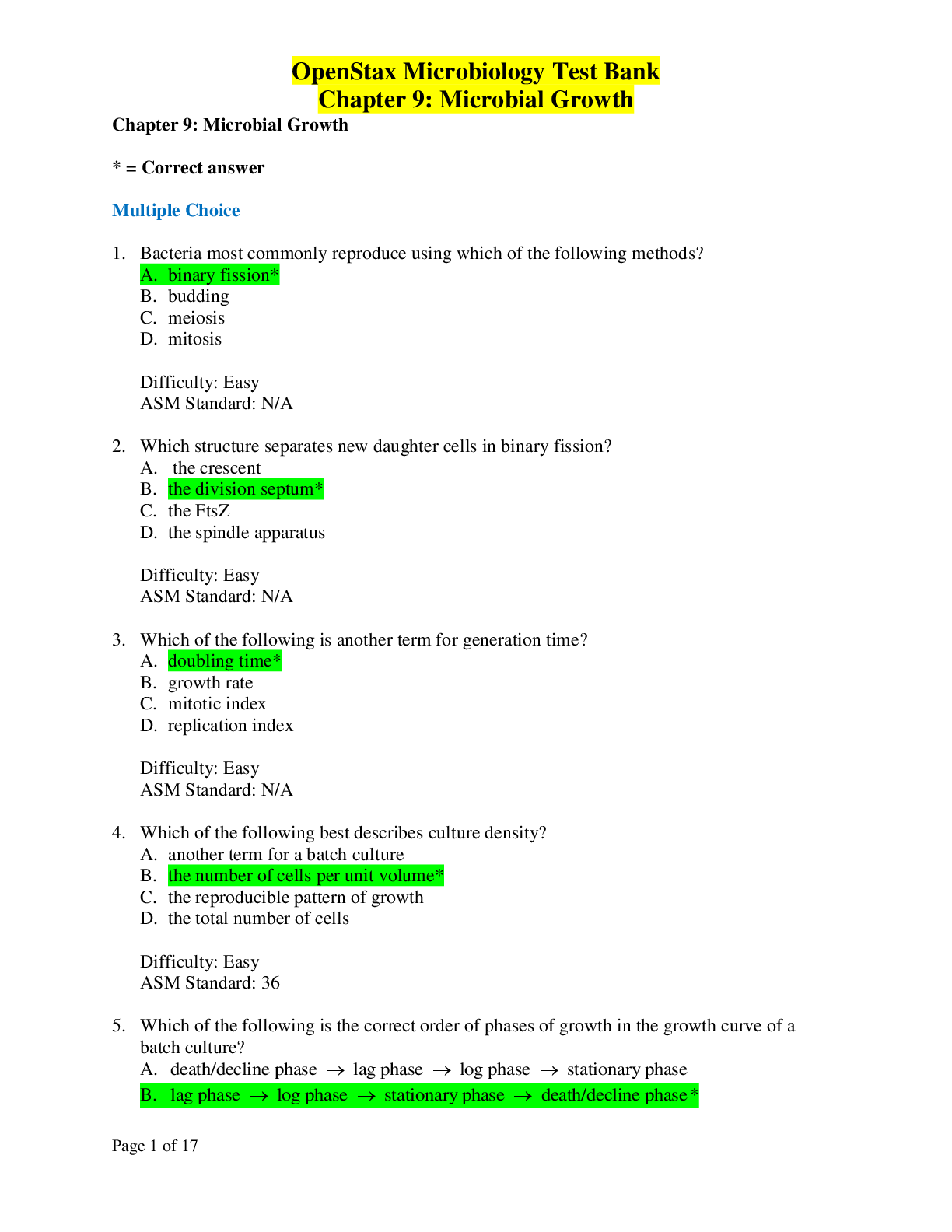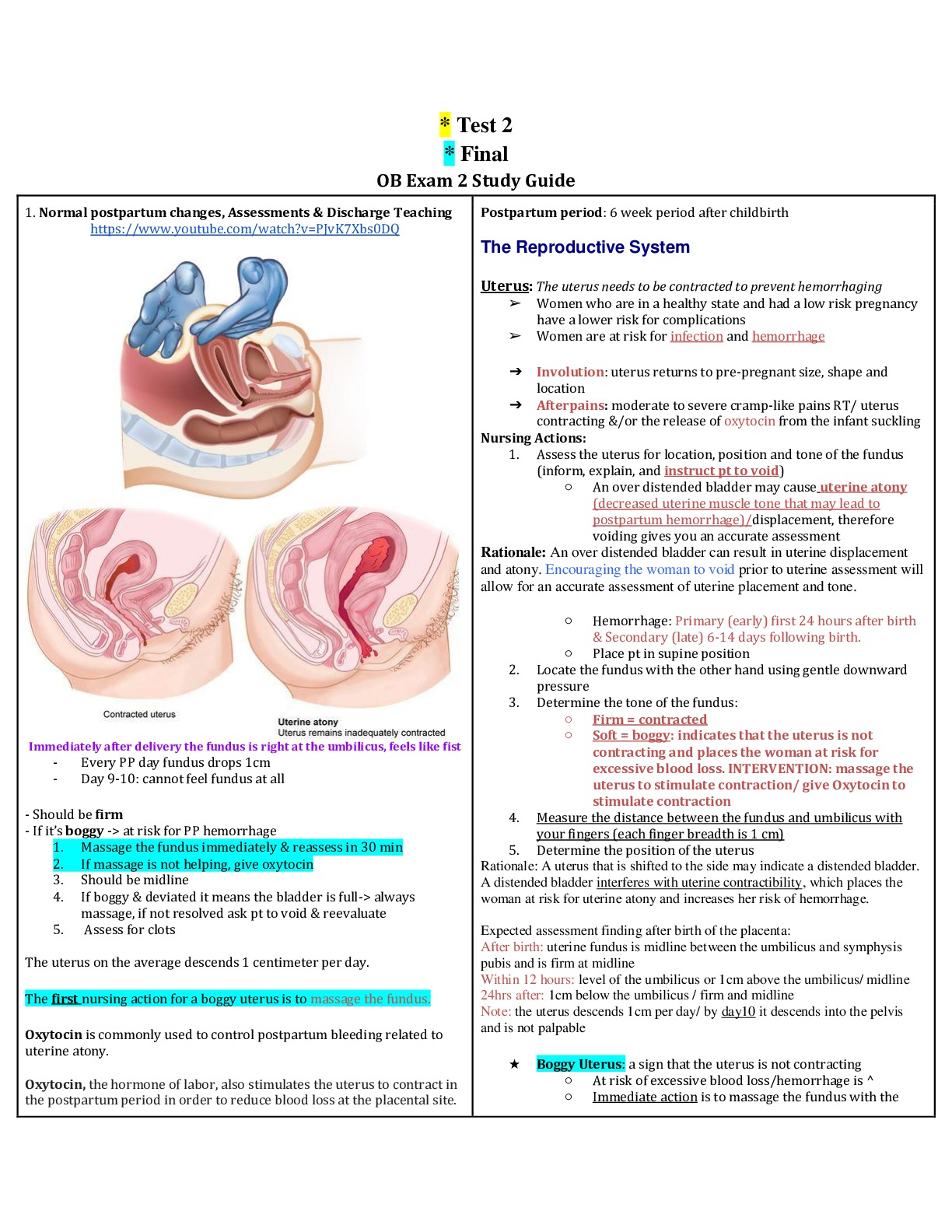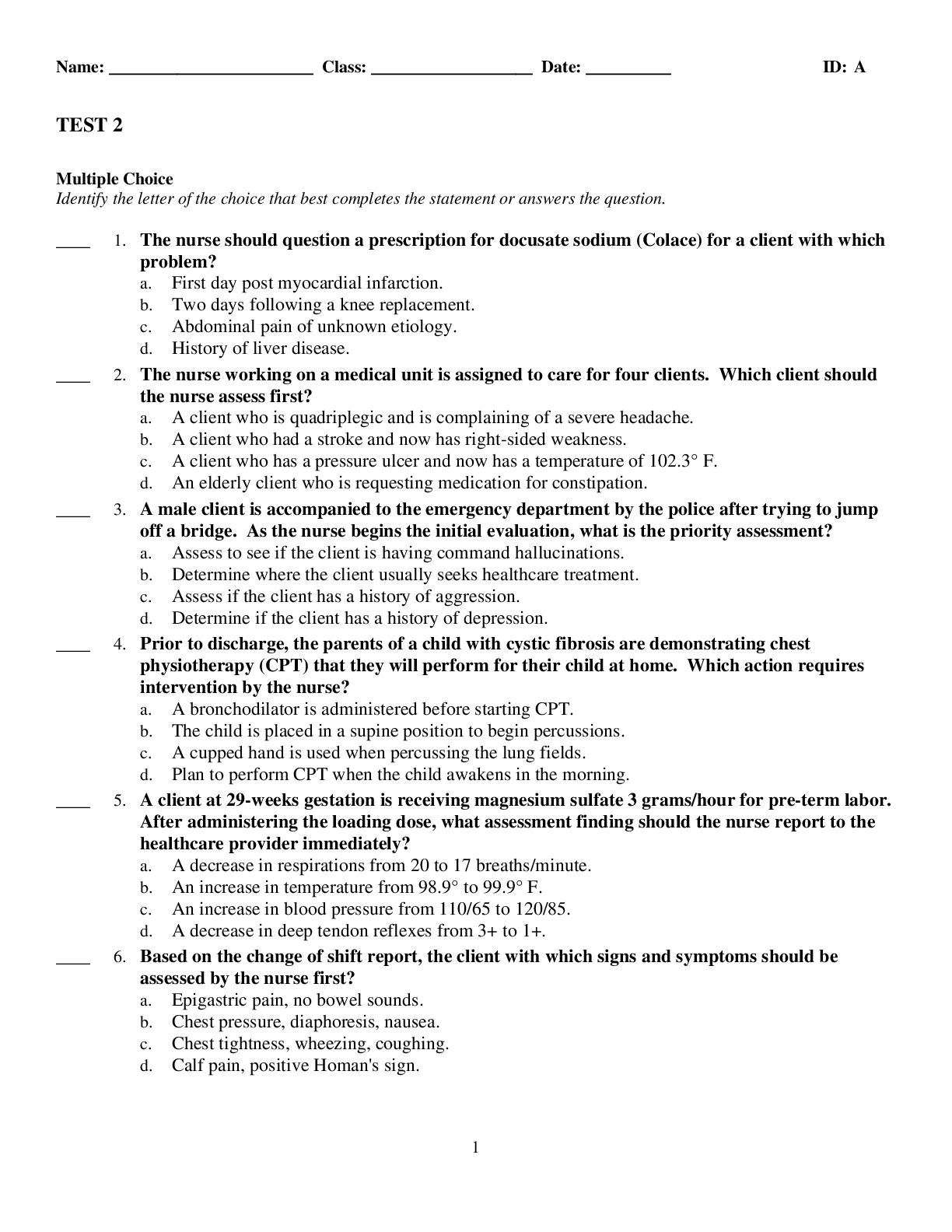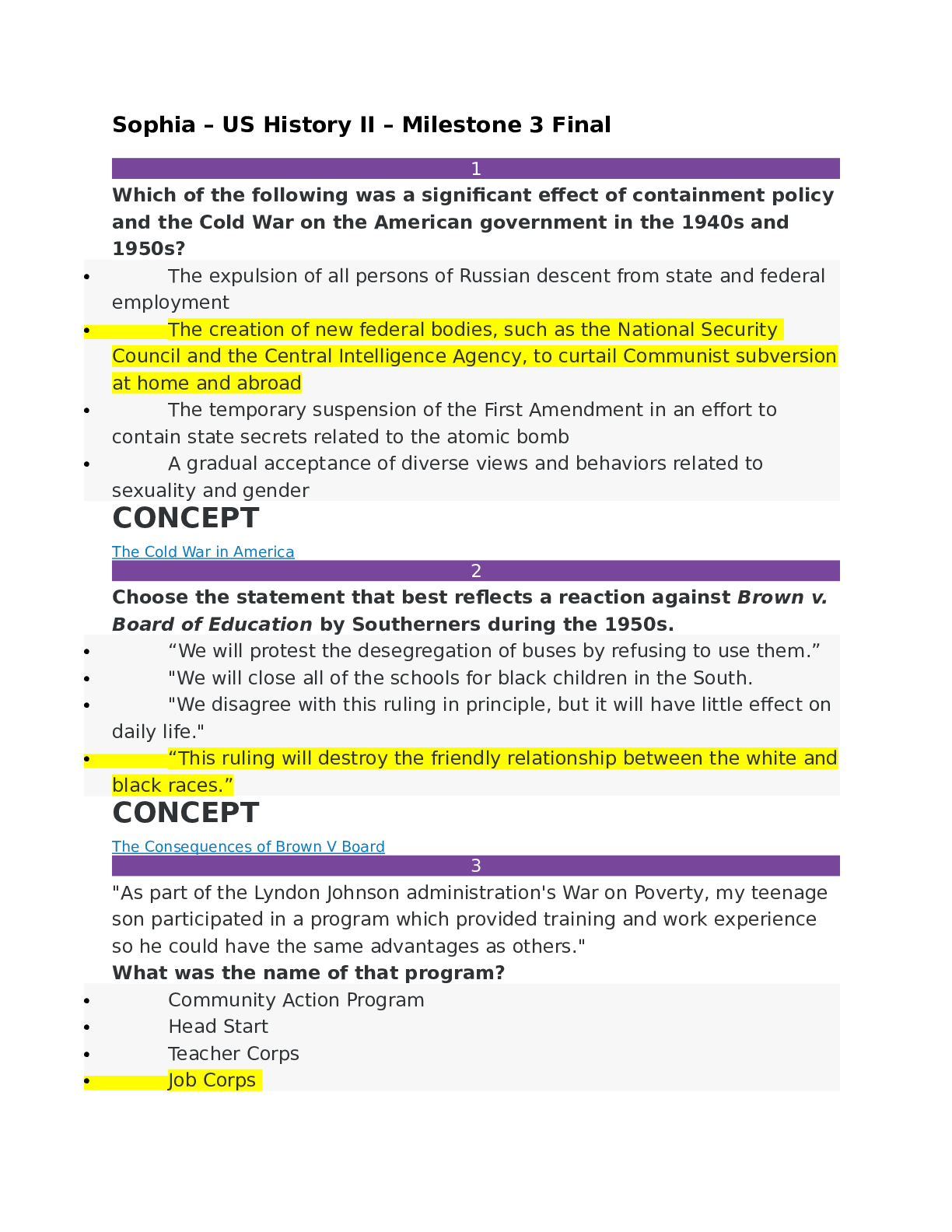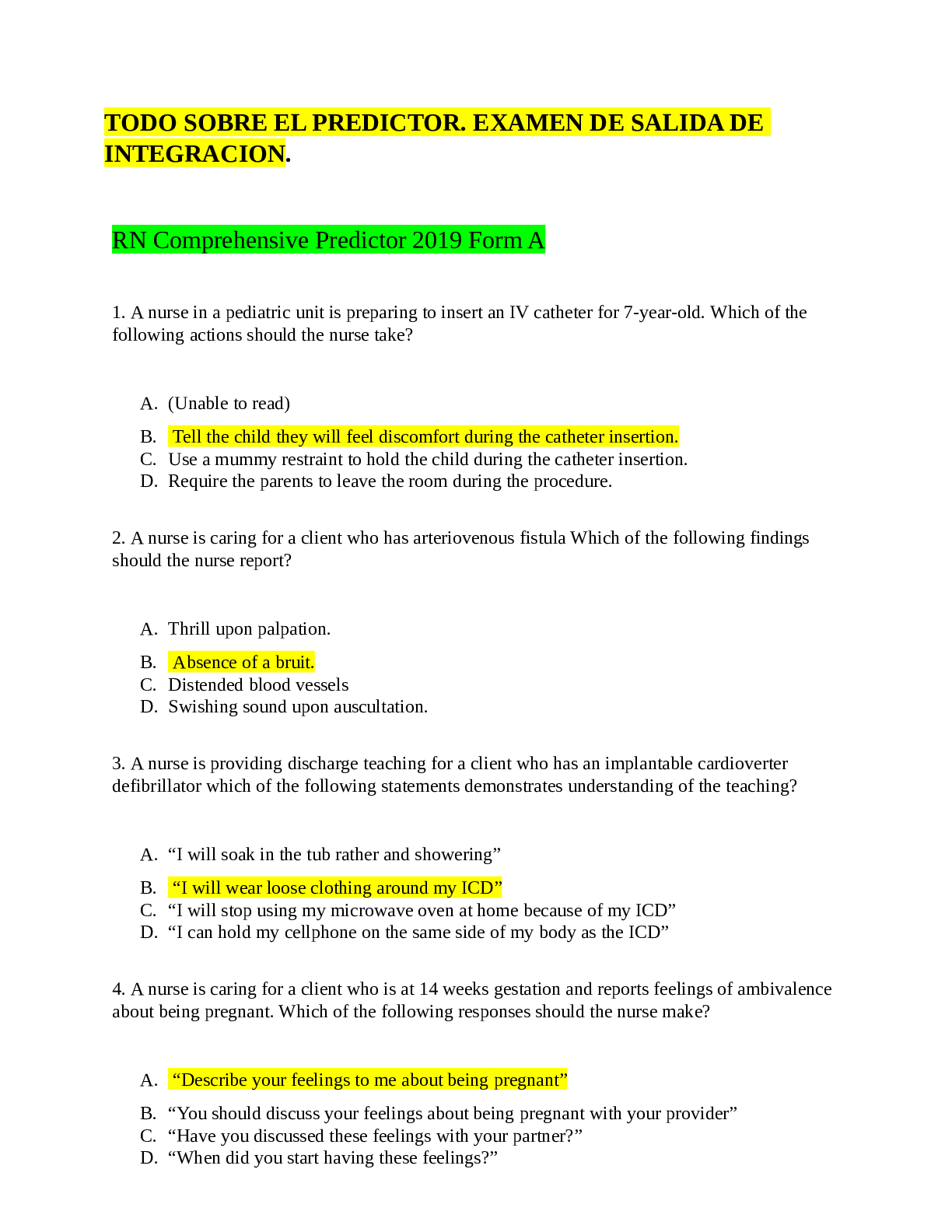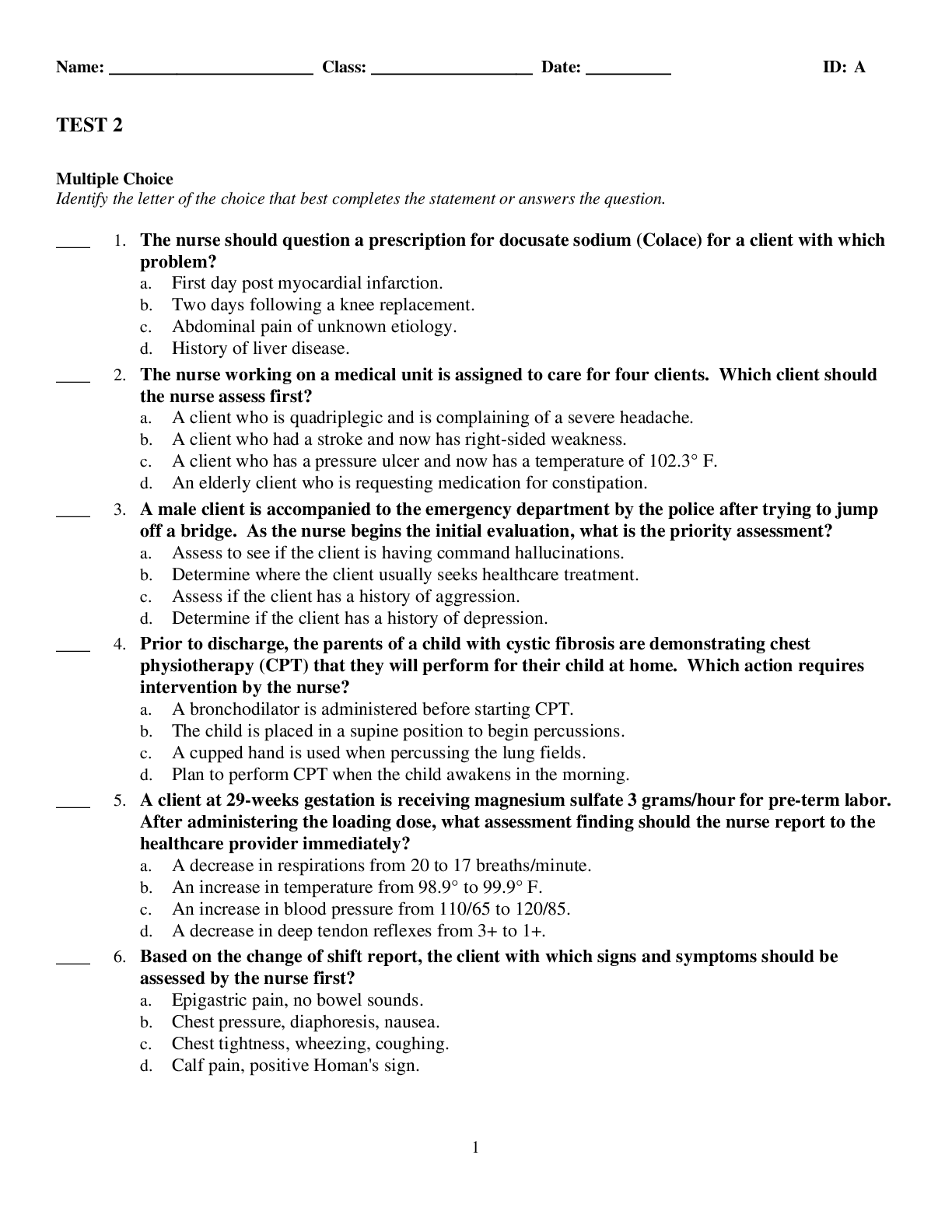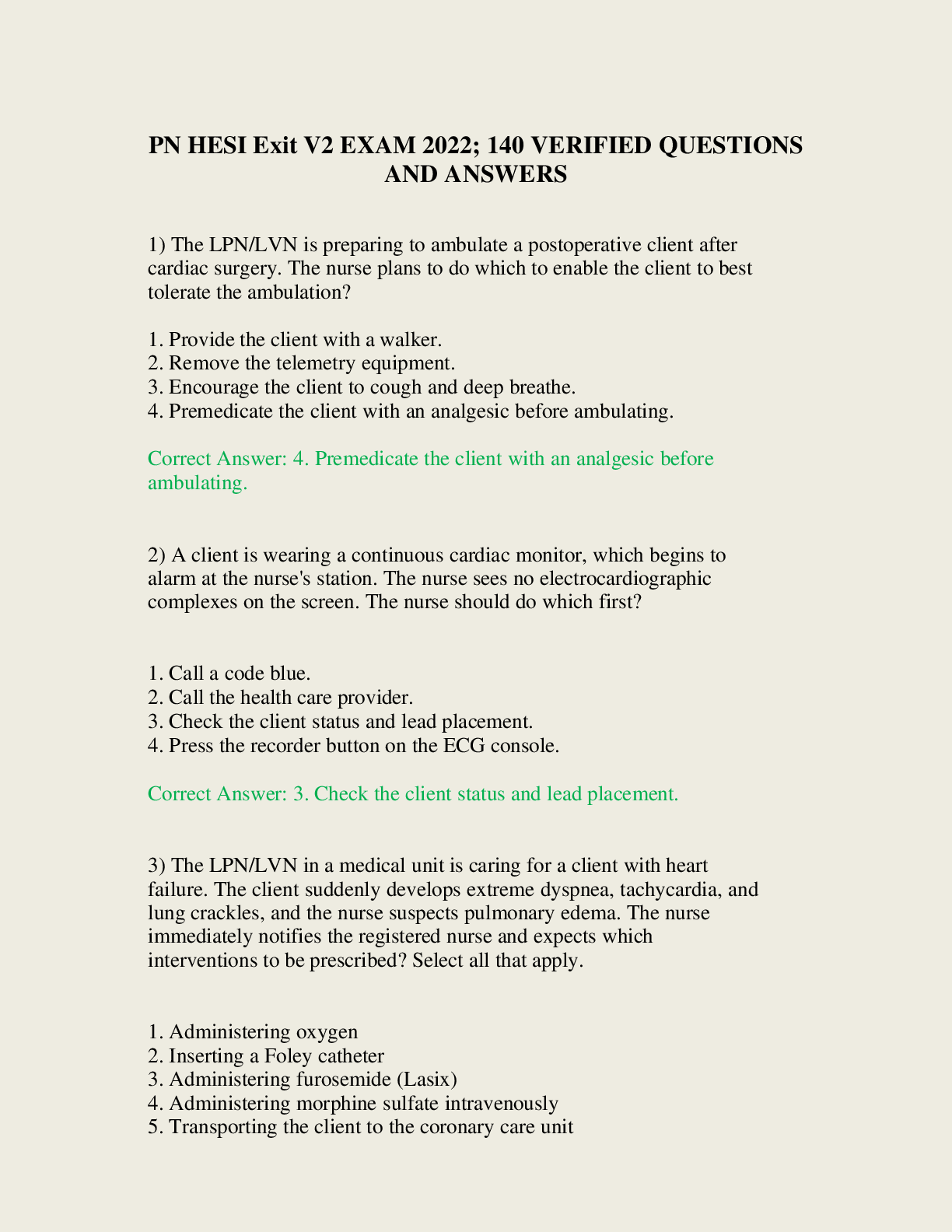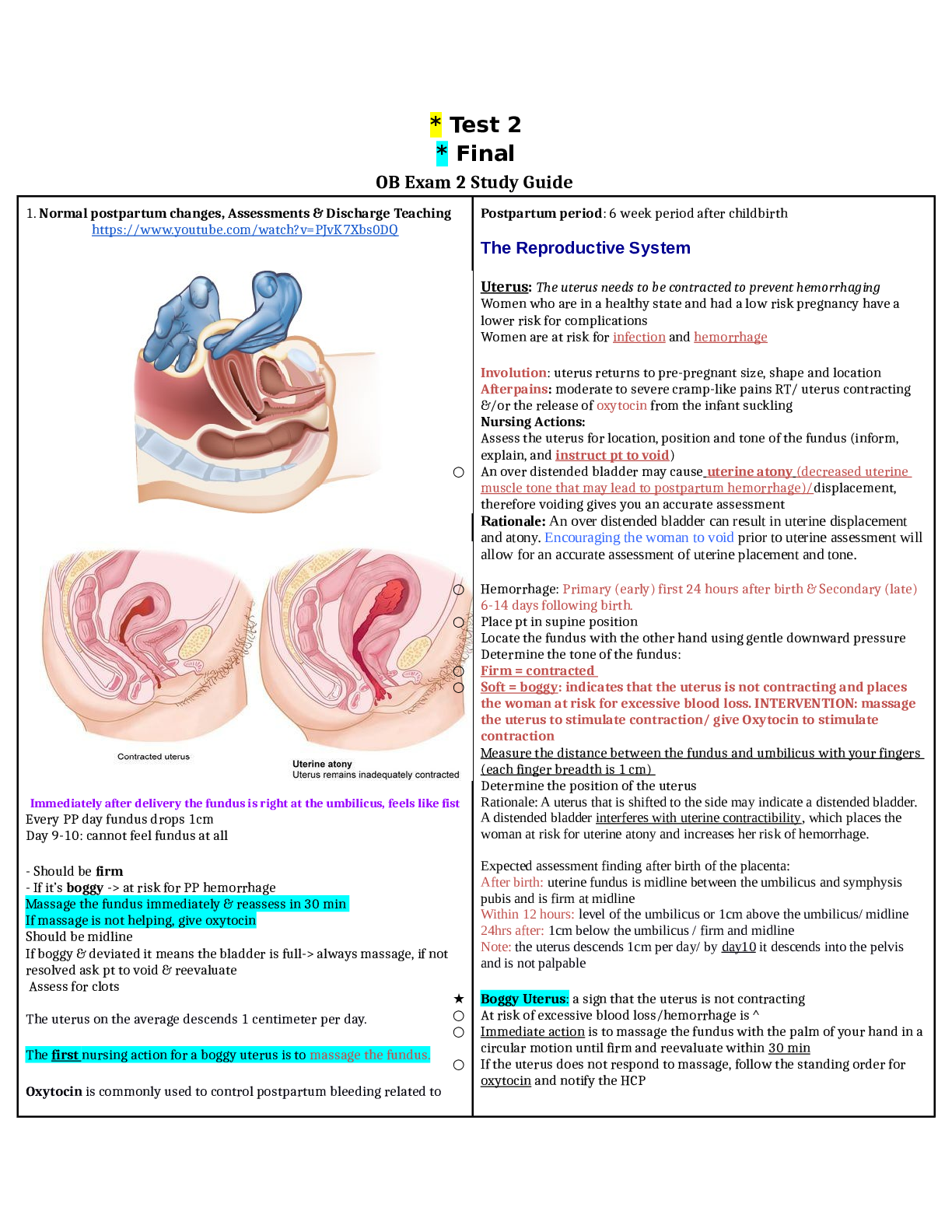Anatomy > QUESTIONS & ANSWERS > SPA 15 - A&P 2.REPRODUCTIVE SYSTEMS, Test Bank (Questions & Answers) A+ Guide - Adelphi University. (All)
SPA 15 - A&P 2.REPRODUCTIVE SYSTEMS, Test Bank (Questions & Answers) A+ Guide - Adelphi University.
Document Content and Description Below
A&P 2.REPRODUCTIVE SYSTEMS STUDY QUESTIONS (answer sheet below the questions) CHAPTERS 28 MULTIPLE CHOICE. Choose the one alternative that best completes the statement or answers the questio... n. 1) The reproductive system includes 1) _________ A) ducts that receive and transport the gametes. B) accessory glands and organs that secrete fluids. C) organs for copulation. D) gonads and external genitalia. E) All of the answers are correct. 2) The reproductive system 2) _________ A) stores gametes. B) nourishes gametes. C) produces gametes. D) transports gametes. E) All of the answers are correct. 3) Sperm are moved along the ductus deferens by 3) _________ A) suction. B) peristaltic contractions. C) ciliary action. D) hydrostatic force. E) hydraulic action. 4) Arrange the four structures listed below into the order in which sperm pass from the testis to the urethral meatus. 1. ductus deferens 2. urethra 3. ejaculatory duct 4. epididymis 4) _________ A) 4, 1, 3, 2 B) 1, 3, 4, 2 C) 4, 3, 1, 2 D) 4, 1, 2, 3 E) 1, 4, 3, 2 5) The organ that monitors and adjusts the composition of tubular fluid, recycles damaged spermatozoa, and is the site of sperm maturation is the 5) _________ A) seminal gland (seminal vesicle). B) ductus deferens. C) rete testis. D) prostate gland. E) epididymis. 6) The organ that carries sperm from the epididymis to the urethra is the 6) _________ A) epididymis. B) ductus deferens. C) ejaculatory duct. D) seminal gland (seminal vesicle). E) corpus cavernosum. 7) The spermatic cord is 7) _________ A) a narrow opening that links the scrotal chamber with the peritoneal cavity. B) a layer of smooth muscle in the skin of the scrotal sac. C) a bundle of tissue that contains the ductus deferens, blood vessels, nerves, and lymphatics that serve the testis. D) a dense layer of connective tissue that surrounds the testis. E) the external marking of the boundary between the two chambers of the scrotum. 8) Interstitial cells produce 8) _________ A) nutrients. B) androgens. C) inhibin. D) sperm. E) androgen-binding protein. 9) The nurse cells of the seminiferous tubules do all of the following, except that they 9) _________ A) secrete testosterone. B) maintain the blood-testis barrier. C) secrete androgen-binding protein. D) support spermiogenesis. E) secrete inhibin. 10) Sperm production occurs in the 10) ________ A) seminiferous tubules. B) rete testis. C) seminal glands (seminal vesicles). D) epididymis. E) ductus deferens. 11) Sperm develop from stem cells called 11) ________ A) primary spermatocytes. B) secondary spermatocytes. C) spermatogonia. D) spermatids. E) spermatozoa. 12) When spermatogonia divide, the daughter cells are called 12) ________ A) spermatozoa. B) spermatogonia. C) spermatocytes. D) spermatids. E) Sertoli cells. 13) The cells that are formed during spermatogenesis by the first meiosis are called 13) ________ A) spermatozoa. B) primary spermatocytes. C) secondary spermatocytes. D) spermatids. E) spermatogonia. 14) The process of spermiogenesis produces 14) ________ A) spermatozoa. B) secondary spermatocytes. C) spermatids. D) primary spermatocytes. E) spermatogonia. 15) The organ that produces a secretion that contains fructose, prostaglandins, and fibrinogen is the 15) ________ A) seminal gland (seminal vesicle). B) preputial gland. C) bulbourethral gland. D) prostate gland. E) corpus cavernosum. 16) The organ that surrounds the urethra and produces an alkaline secretion is the 16) ________ A) preputial gland. B) Bartholin's gland. C) seminal gland (seminal vesicle). D) bulbourethral gland. E) prostate gland. 17) The small paired structures at the base of the penis that secrete a thick, alkaline mucus are the 17) ________ A) seminal vesicles. B) Bartholin glands. C) preputial glands. D) bulbo-urethral glands. E) prostate glands. 18) Semen contains all of the following, except 18) ________ A) seminal fluid. B) prostaglandins. C) fibrinogen. D) spermatogonia. E) spermatozoa. 19) The special type of cell division required to produce gametes is called 19) ________ A) maturation. B) capacitation. C) meiosis. D) mitosis. E) fertilization. 20) The organ that delivers semen into the female reproductive tract is the 20) ________ A) ejaculatory duct. B) corpus spongiosum. C) urethra. D) penis. E) corpus cavernosum. 21) The urethral meatus is an opening in the 21) ________ A) glans penis. B) corpus spongiosum. C) corona radiata. D) corpus cavernosum. E) prepuce. 22) The erectile tissue that surrounds the urethra is the 22) ________ A) membranous urethra. B) corpus spongiosum. C) glans penis. D) penile urethra. E) corpus cavernosum. 23) The paired erectile bodies in the penis are the 23) ________ A) penile urethra. B) prepuce. C) corpora cavernosa. D) corpus spongiosum. E) membranous urethra. 24) The role of FSH in males is to 24) ________ A) stimulate the interstitial cells to produce testosterone. B) initiate sperm production in the testes. C) influence sexual behaviors and sex drive. D) stimulate the nurse cells to produce inhibin. E) develop and maintain secondary sex characteristics. 25) The pituitary hormone that stimulates the interstitial cells to secrete testosterone is 25) ________ A) ADH. B) FSH. C) GH. D) LH. E) ACTH. 26) Which of the following glands secretes fructose to nourish the sperm? 26) ________ A) bulbourethral gland B) prepuce C) rete testis D) prostate gland E) seminal gland (seminal vesicle) 27) Which of the following can be found inside the spermatic cord? 27) ________ A) blood vessels B) ductus deferens C) nerves D) lymphatic vessels E) All of the answers are correct. 28) Nurse cells 28) ________ A) form the blood-testis barrier. B) secrete the hormone inhibin. C) coordinate spermatogenesis. D) are found in the seminiferous tubules. E) All of the answers are correct. 29) A primary spermatocyte matures into ________ spermatids having ________ chromosomes. 29) ________ A) millions of; 23 B) millions of; 46 C) four; 46 D) four; 23 E) one; 46 30) The special type of cell division required to produce gametes is called 30) ________ A) meiosis. B) capacitation. C) mitosis. D) fertilization. E) maturation. 31) Spermatozoa are functionally matured within the 31) ________ A) epididymis. B) seminal gland (seminal vesicle). C) rete testes. D) seminiferous tubules. E) ductus deferens. 32) Interstitial cells 32) ________ A) respond to luteinizing hormone. B) produce testosterone. C) are located between seminiferous tubules. D) are also called Leydig cells. E) All of the answers are correct. 33) Testicular nurse cells function in all of the following ways, except that they don't 33) ________ A) secrete Müllerian inhibiting factor. B) coordinate spermiogenesis. C) secrete progesterone-binding protein. D) support meiosis. E) serve as a blood-testis barrier. 34) A typical ejaculation releases approximately ________ sperm. 34) ________ A) 800 million B) 100,000 C) 250 million D) 20 million E) 1 million 35) Secondary spermatocytes each contain 35) ________ A) 23 pairs of chromosomes. B) 23 chromosomes. C) twice the diploid number of chromosomes. D) 46 chromosomes. E) 46 pairs of chromosomes. 36) Testosterone is secreted by the 36) ________ A) nurse cells. B) suprarenal cortex. C) adenohypophysis. D) hypothalamus. E) interstitial cells. 37) If the prostate stopped secreting fluid, this would result in semen 37) ________ A) with no mucus. B) that was rich in prostaglandins. C) that lacked sperm. D) with less fructose. E) with a higher than normal pH. 38) Functions of the accessory glands of the male reproductive system include all of the following, except 38) ________ A) propelling spermatozoa and fluids along the reproductive tract. B) producing buffers. C) activating the spermatozoa. D) meeting the nutrient needs of spermatozoa for motility. E) production of spermatozoa. 39) A boy has a genetic mutation such that FSH is not produced, but LH is normal. After the boy grows to maturity, it is likely he will 39) ________ A) not develop secondary sex characteristics. B) produce large amounts of inhibin. C) have impaired function of the interstitial cells. D) be sterile. E) be impotent. 40) A male bodybuilder starts taking injections of testosterone (an anabolic steroid) on a daily basis. After 3 weeks, which of the following would you expect to observe? 40) ________ A) increased sex drive B) decreased levels of GnRH C) increased muscle mass D) decreased levels of LH and FSH E) All of the answers are correct. Figure 28-1 The Male Reproductive System Use Figure 28-1 to answer the following questions: 41) Identify the structure labeled "11." 41) ________ A) prostate gland B) seminal gland (seminal vesicle) C) epididymis D) ductus deferens E) bulbourethral gland 42) Identify the structure labeled "3." 42) ________ A) corpora cavernosa B) ejaculatory duct C) spongy urethra D) prostatic urethra E) corpus spongiosum 43) What is produced by the structure labeled "7"? 43) ________ A) spermatozoa and testosterone B) spermatozoa C) FSH D) seminal fluids E) testosterone 44) Identify the structure labeled "4." 44) ________ A) epididymis B) testis C) ductus deferens D) prostate gland E) seminal gland (seminal vesicle) 45) Identify the structure that produces a fructose-rich fluid. 45) ________ A) 11 B) 9 C) 13 D) 10 E) 12 46) Identify the structure labeled "12." 46) ________ A) vas deferens B) prostatic urethra C) membranous urethra D) ejaculatory duct E) ductus deferens 47) Identify the structure labeled "6." 47) ________ A) epididymis B) seminiferous tubule C) testis D) ejaculatory duct E) ductus deferens 48) Identify the structure labeled "1." 48) ________ A) corpora cavernosa B) membranous urethra C) ejaculatory duct D) membranous urethra E) corpus spongiosum 49) Identify the structure labeled "9." 49) ________ A) cremaster muscle B) testis C) prepuce D) scrotum E) ductus deferens 50) Identify the structure labeled "2." 50) ________ A) penile urethra B) ejaculatory duct C) corpus spongiosum D) membranous urethra E) corpora cavernosa 51) Which of the following descriptions best matches the term endometrium? 51) ________ A) supports the uterus laterally B) after ovulation, the ovum is captured by it C) supports the uterus anteriorly D) consists of a functional zone and a basilar zone E) thick layer of smooth muscle cells 52) The broad ligament is 52) ________ A) a thickened fold of mesentery that supports and stabilizes the position of the ovary. B) an extensive mesentery that encloses the ovaries, uterine tubes, and uterus. C) a pocket formed between the posterior wall of the uterus and the anterior surface of the rectum. D) a structure that anchors the ovary to the rectouterine pouch. E) a structure that extends from the lateral surface of the ovary to the pelvic wall. 53) The organ that transports the ovum to the uterus is the 53) ________ A) vagina. B) uterosacral ligament. C) myometrium. D) infundibulum. E) uterine tube. 54) The organ that provides mechanical protection and nutritional support for the developing embryo is the 54) ________ A) vagina. B) ovary. C) uterine tube. D) cervix. E) uterus. 55) The inferior portion of the uterus that projects into the vagina is the 55) ________ A) isthmus. B) body. C) fornix. D) cervix. E) fundus. 56) The thick muscular layer of the uterus is the 56) ________ A) myometrium. B) uterometrium. C) sarcometrium. D) endometrium. E) perimetrium. 57) Each of the following statements concerning oogenesis is true, except that 57) ________ A) by the time of their birth, girls have already lost about 80 percent of their oocytes. B) oogenesis begins before birth. C) an ovum completes its last meiosis after it is fertilized. D) about half the oogonia complete mitosis between birth and puberty. E) ova develop from stem cells called oogonia. 58) The surge in luteinizing hormone that occurs during the middle of the ovarian cycle triggers 58) ________ A) menstruation. B) follicle maturation. C) ovulation. D) menopause. E) atresia. 59) A rise in the blood levels of follicle-stimulating hormone at the beginning of the ovarian cycle is responsible for 59) ________ A) atresia. B) menstruation. C) ovulation. D) menopause. E) follicle maturation. 60) The average length of the menstrual cycle is 60) ________ A) 35 days. B) 16 days. C) 28 days. D) 21 days. E) 19 days. 61) During the proliferative phase of the menstrual cycle, 61) ________ A) the fertilized ovum implants. B) the functional zone of the endometrium is restored. C) the corpus luteum is forming. D) the endometrium finalizes the preparation for implantation. E) the old functional layer is sloughed off. 62) During the secretory phase of the menstrual cycle 62) ________ A) the corpus luteum is formed. B) the fertilized ovum implants. C) progesterone levels are high. D) endometrial glands enlarge. E) All of the answers are correct. 63) During the menses 63) ________ A) a new uterine lining is formed. B) the corpus luteum is most active. C) the old functional layer is sloughed off. D) progesterone levels are high. E) secretory glands and blood vessels develop in the endometrium. 64) All of the following are true of the vagina, except that it 64) ________ A) serves as a passageway for the elimination of menstrual fluids. B) receives the penis during coitus. C) loses a portion of its lining during menses. D) forms the lower portion of the birth canal. E) holds spermatozoa prior to their passage to the uterus. 65) The vagina is 65) ________ A) a muscular tube extending between the uterus and the anus. B) lined by simple columnar epithelium rich in goblet cells. C) another term for the cervix. D) similar to the inner lining of the uterus. E) a muscular tube extending between the uterus and the external genitalia. 66) The vulva includes all of the following, except the 66) ________ A) labia minora. B) mons pubis. C) clitoris. D) labia majora. E) vagina. 67) The uterine phase that develops because of a fall in progesterone levels is 67) ________ A) the luteal phase. B) the follicular phase. C) the proliferative phase. D) the secretory phase. E) the menses. 68) The space bounded by the labia minora is the 68) ________ A) clitoris. B) fornix. C) vestibule. D) hymen. E) isthmus. 69) Fatty folds of skin that encircle and partially conceal the labia minora and vestibule are the 69) ________ A) vestibular arches. B) ampullae. C) fornices. D) mons pubis. E) labia majora. 70) The clitoris 70) ________ A) engorges with blood during sexual arousal. B) is topped by a small erectile glans. C) contains erectile tissue comparable to the corpora cavernosa of the penis. D) is derived from the same embryonic structures as the penis in males. E) All of the answers are correct. 71) The pigmented skin that surrounds the nipple is the 71) ________ A) zona reticularis. B) fornix. C) areola. D) zona pellucida. E) peripapilla. 72) The principal hormone secreted by the corpus luteum is 72) ________ A) progesterone. B) LH. C) estrogen. D) luteosterone. E) FSH. 73) Menstruation is triggered by a drop in the levels of 73) ________ A) FSH. B) inhibin. C) relaxin. D) progesterone. E) LH. 74) The granulosa cells of developing follicles secrete 74) ________ A) estradiol. B) GnRH. C) progesterone. D) FSH. E) LH. 75) Which of the following is not an action of estrogen? 75) ________ A) mimics the symptoms of menopause B) initiates repair of the endometrium C) maintains accessory reproductive organs D) maintains female secondary sex characteristics E) stimulates bone growth 76) The ________ is the portion of the uterus that projects into the vagina. 76) ________ A) fundus B) cervix C) body D) internal os E) myometrium 77) The ________ is the region of the vagina that surrounds the cervix. 77) ________ A) fornix B) fundus C) dartos D) rugae E) external os 78) Which region of the uterine tube captures the ovum? 78) ________ A) infundibulum B) posterior segment C) anterior segment D) isthmus E) ampulla 79) The ________ is the rounded portion of the uterine body superior to the attachment of the uterine tubes. 79) ________ A) fundus B) body C) myometrium D) internal os E) cervix 80) The portion of the uterine tube that ends in fingerlike fimbriae is the 80) ________ A) proximal segment. B) infundibulum. C) distal segment. D) ampulla. E) isthmus. 81) The primary follicle develops from the 81) ________ A) ovarian follicles. B) granulosa cells. C) ovarian stroma. D) ovarian hilum. E) primordial follicle. 82) Which of the following descriptions best matches the term myometrium? 82) ________ A) after ovulation, the ovum is captured by it B) thick layer of smooth muscle cells C) supports the uterus anteriorly D) consists of a functional zone and a basilar zone E) supports the uterus laterally 83) The segment of the uterine tube where fertilization commonly occurs is the 83) ________ A) posterior. B) fimbriae. C) boundary between the ampulla and isthmus. D) ampulla. E) infundibulum. 84) Which of the following is not a similarity between the testis and ovary? 84) ________ A) meiosis takes place in both B) both produce gametes C) both respond to follicle-stimulating hormone D) both respond to luteinizing hormone E) both produce progesterone 85) Which is the function of the ovaries? 85) ________ A) production of oocytes B) formation of immature gametes C) secretion of hormones D) secretion of inhibin E) All of the answers are correct. 86) The ________ is the largest portion of the uterus. 86) ________ A) cervix B) internal os C) myometrium D) body E) fundus 87) Another term for vulva is 87) ________ A) gonads. B) vagina. C) labia. D) accessory glands. E) female external genitalia. 88) A sample of a woman's blood is analyzed for reproductive hormone levels. The results indicate a high level of progesterone, relatively high levels of inhibin, and low levels of FSH and LH. The female is most likely experiencing ________ of the uterine cycle. 88) ________ A) the secretory phase B) menarche C) menses D) menopause E) the proliferative phase 89) Follicle-stimulating hormone 89) ________ A) stimulates ovulation. B) stimulates the thyroid follicles. C) stimulates maturation of primordial follicles in the ovary. D) is important only in females. E) All of the answers are correct. 90) A mature follicle releases an ovum in response to a surge in 90) ________ A) luteinizing hormone. B) follicle-stimulating hormone. C) estrogen. D) oxytocin. E) progesterone. 91) After ovulation, the ovary secretes 91) ________ A) estrogen. B) luteinizing hormone. C) progesterone. D) luteinizing hormone, estrogen, and progesterone. E) both estrogen and progesterone. 92) A drug that blocked the enzyme aromatase would do what to a patient? 92) ________ A) increase the risk of osteoporosis B) bring on symptoms of menopause C) prevent the synthesis of estrogen D) reduce the risk of breast cancer E) All of the answers are correct. 93) Which of the following descriptions best matches the term uterine tube? 93) ________ A) has stratified squamous epithelium B) covers the glans penis or glans clitoris C) passes through erectile tissue in males D) has ciliated epithelium E) where mature sperm are stored and processed 94) Which of the following statements about the menstrual cycle is true? 94) ________ A) it is ultimately controlled by GnRH B) is skipped in pregnancy C) often involves painful myometrial contraction D) the first occurrence is termed menarche E) All of the answers are correct. Figure 28-2 The Female Reproductive System Use Figure 28-2 to answer the following questions: 95) Identify the structure labeled "2." 95) ________ A) ureter B) vagina C) clitoris D) uterine tube E) ovary 96) Identify the structure labeled "6." 96) ________ A) cervix B) greater vestibular gland C) clitoris D) vagina E) uterus 97) What is produced by the structure labeled "1"? 97) ________ A) estrogen B) progesterone C) inhibin D) ovary E) All of the answers are correct. 98) Which structure is lined by a ciliated epithelium? 98) ________ A) 12 B) 1 C) 9 D) 11 E) 2 99) Identify the structure labeled "12." 99) ________ A) ovary B) clitoris C) labium minus D) vagina E) uterus 100) Identify the structure labeled "7." 100) _______ A) vagina B) labium minus C) clitoris D) labium majus E) greater vestibular gland 101) Identify the structure labeled "8." 101) _______ A) labium majus B) vagina C) clitoris D) greater vestibular gland E) labium minus 102) Identify the structure labeled "10." 102) _______ A) areola B) ampulla C) cervical canal D) cervix E) fornix 103) Identify the structure labeled "5." 103) _______ A) ureter B) uterine tube C) urethra D) vagina E) cervix 104) In which structure does gestation occur? 104) _______ A) 13 B) 4 C) 11 D) 1 E) 9 105) Emission and ejaculation 105) _______ A) begins with peristaltic contractions of the ampulla. B) is responsible for propelling semen into the female reproductive tract. C) involves contractions of the bulbospongiosus muscle. D) occurs under sympathetic stimulation. E) All of the answers are correct. 106) Contractions of the bulbospongiosus muscles result in 106) _______ A) ejaculation. B) detumescence. C) erection. D) impotence. E) emission. 107) Which of the following is (are) a type of sexually transmitted disease? 107) _______ A) genital herpes B) gonorrhea C) AIDS D) chlamydia E) All of the answers are correct. 108) For erection to occur 108) _______ A) there must be sufficient blood hydrostatic pressure. B) nitric oxide must be present. C) blood flow to the penis must increase. D) the sacral spinal cord must be intact. E) All of the answers are correct. 109) Which of the following does not occur after menopause? 109) _______ A) menstrual cycles cease B) ovulation ceases C) estrogen levels rise D) FSH secretion increases E) GnRH secretion increases SHORT ANSWER. Write the word or phrase that best completes each statement or answers the question. 110) The male gonad is called a(n) ________. 110) ______________ 111) The ________ is a layer of smooth muscle in the skin of the scrotal sac. 111) ______________ 112) Spermatids mature into spermatozoa by the process of ________. 112) ______________ 113) The ________ is the part of the sperm that contains the DNA. 113) ______________ 114) The middle piece of the sperm contains the ________ in a spiral arrangement. 114) ______________ 115) The only ________ in the human body is the tail of the sperm. 115) ______________ 116) A normal sperm count ranges from approximately ________ spermatozoa per milliliter. 116) ______________ 117) The ________ within the head of a sperm contains the enzymes essential for fertilization. 117) ______________ 118) A spermatozoon passes through the epididymis in about ________ weeks. 118) ______________ 119) Primary spermatocytes are produced by mitosis of cells called ________. 119) ______________ 120) The portion of the urethra that passes through the prostate is called the ________. 120) ______________ 121) The term ________ means the failure of one or both testes to descend into the scrotum by the time of birth. 121) ______________ 122) The most important androgen is ________. 122) ______________ 123) The portion of the urethra that passes through the corpus spongiosum to the external urethral meatus is the ________. 123) ______________ 124) The surgical removal of the prepuce is called ________. 124) ______________ 125) The ________ carries fluid from the seminal gland (seminal vesicle) through the prostate. 125) ______________ 126) The ductus deferens passes through the ________ canal to enter the pelvic cavity. 126) ______________ 127) The organ inferior to the urinary bladder and contains the urethra in the middle is the ________ gland. 127) ______________ 128) The hormone that stimulates spermatogenesis in males is ________. 128) ______________ 129) The interstitial cells in the testes produce ________. 129) ______________ 130) The cremaster muscle can raise and lower the testes to regulate ________ of the testes. 130) ______________ 131) The hormone that stimulates ovulation is ________. 131) ______________ 132) The hood that covers the clitoris is called the ________. 132) ______________ 133) The muscle layer of the uterus is the ________. 133) ______________ 134) The ________ are fingerlike projections that capture the freshly ovulated ovum. 134) ______________ 135) The expanded, initial segment of the uterine tube is called the ________. 135) ______________ 136) The ________ of the uterine tube is between the uterus the ampulla. 136) ______________ 137) Sperm enter the cervical canal through the external ________. 137) ______________ 138) The main portion of the uterus is called the corpus or ________. 138) ______________ 139) The portion of the uterus that projects into the vagina is called the ________. 139) ______________ 140) The ________ is the inner lining of the uterus. 140) ______________ 141) The internal os connects the uterine cavity to the ________. 141) ______________ 142) The shallow recess that surrounds the cervical protrusion into the vagina is called the ________. 142) ______________ 143) The ________ is the glycoprotein-rich region between the developing oocyte and the granulosa cells. 143) ______________ 144) The fluid-filled cavity that appears in a secondary follicle is called the ________. 144) ______________ 145) The ________ consists of the follicle cells that cling to the oocyte after ovulation. 145) ______________ 146) ________ is a procedure that uses x-rays to examine breast tissue for the presence of cancer. (Note: Be sure to capitalize the first letter of your answer). 146) ______________ 147) The surgical procedure in which the entire breast is removed is called a ________. 147) ______________ 148) ________ is the process of sloughing off the old functional layer of the endometrium. (Note: Be sure to capitalize the first letter of your answer). 148) ______________ 149) The ________ provides mechanical protection, nutritional support, and waste removal for the developing embryo. 149) ______________ 150) After menopause, the production of two pituitary hormones increases. They are FSH and ________. 150) ______________ 151) The ________ is the endometrial layer that undergoes dramatic changes during the menstrual cycle. 151) ______________ 152) Painful menstruation is called ________. 152) ______________ 153) An inflammation of the vaginal canal caused by fungi, bacteria, or parasites is called ________. 153) ______________ 154) The ________ is an elastic epithelial layer between the vagina and vestibule, which, if present, is often torn during first intercourse. 154) ______________ 155) The organs of milk production are ________. 155) ______________ 156) The first menses is called the ________. 156) ______________ 157) Impotence is defined as an inability to achieve or maintain an ________. 157) ______________ 158) Ejaculation is associated with intensely pleasurable sensations, an experience known as male ________. 158) ______________ 159) The subsidence of an erection after ejaculation is known as ________. 159) ______________ 160) The cessation of menstruation after no more developing follicles remain is called ________. 160) ______________ ESSAY. Write your answer in the space provided or on a separate sheet of paper. 161) How does mitosis differ from meiosis? 162) The release of FSH and LH from gonadotropes in the adenohypophysis is separately controlled by the same hypothalamic releasing hormone, GnRH. How is it possible to organize their secretion during the menstrual cycle? 163) How are male and female reproductive systems functionally different? [Show More]
Last updated: 1 year ago
Preview 1 out of 25 pages
Instant download
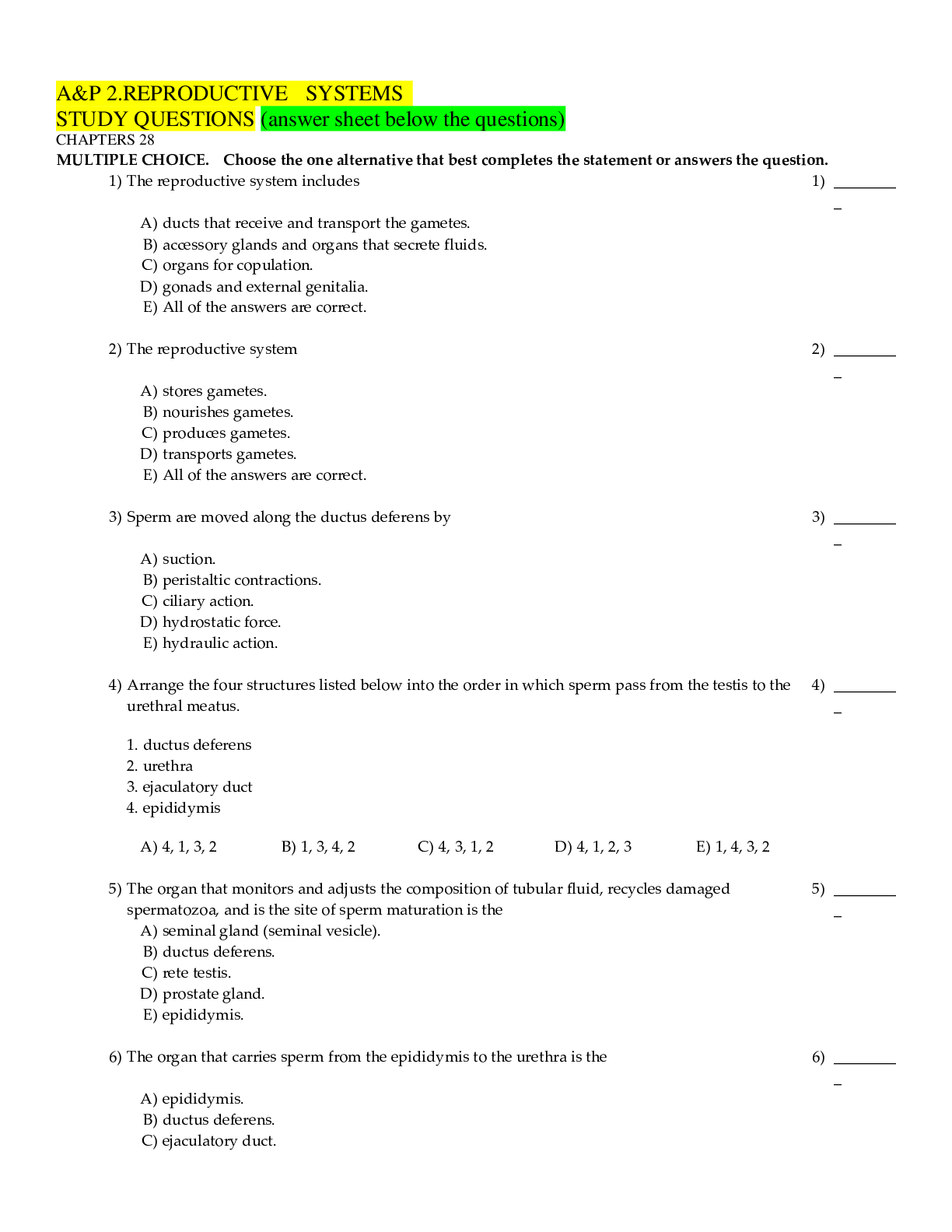
Buy this document to get the full access instantly
Instant Download Access after purchase
Add to cartInstant download
Reviews( 0 )
Document information
Connected school, study & course
About the document
Uploaded On
Mar 25, 2020
Number of pages
25
Written in
Additional information
This document has been written for:
Uploaded
Mar 25, 2020
Downloads
0
Views
149

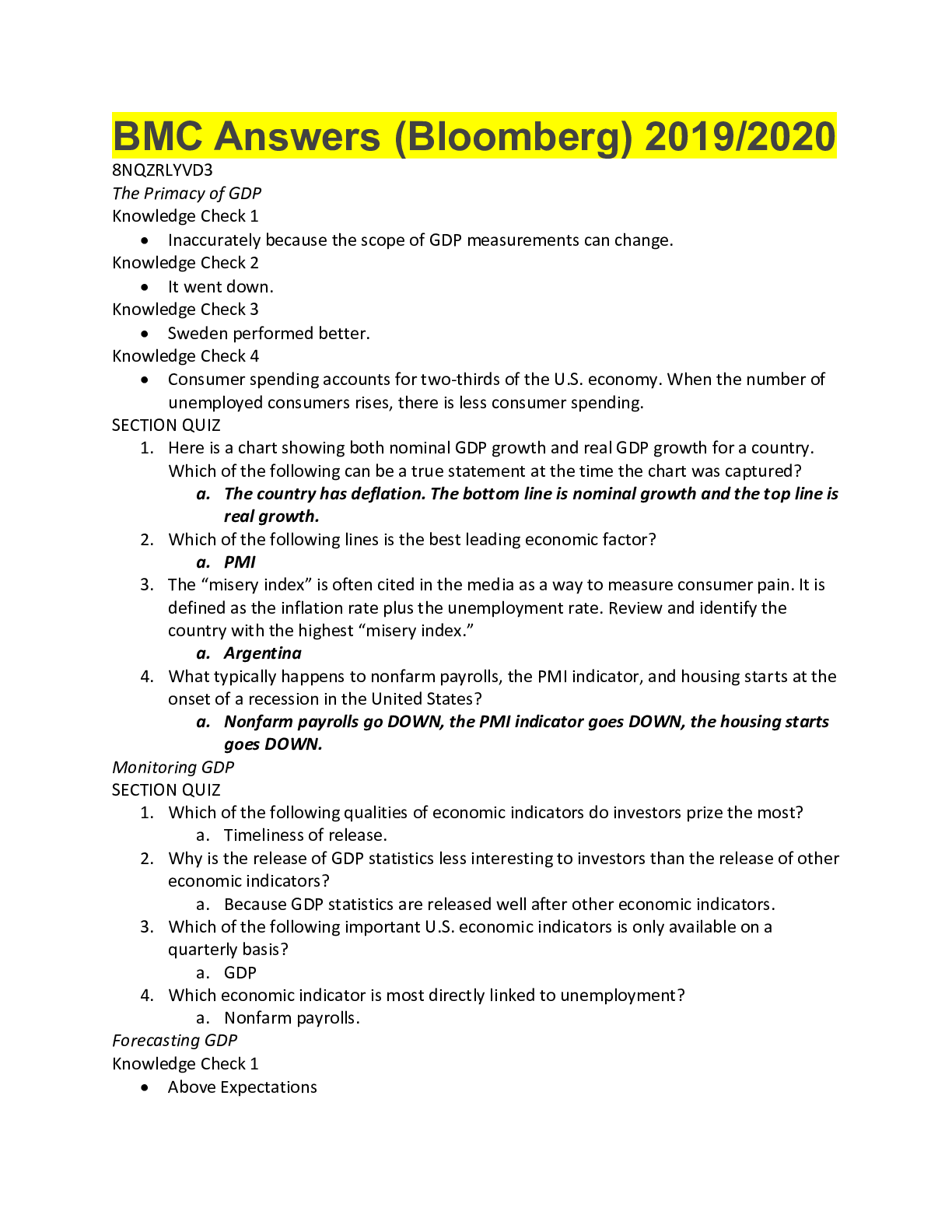
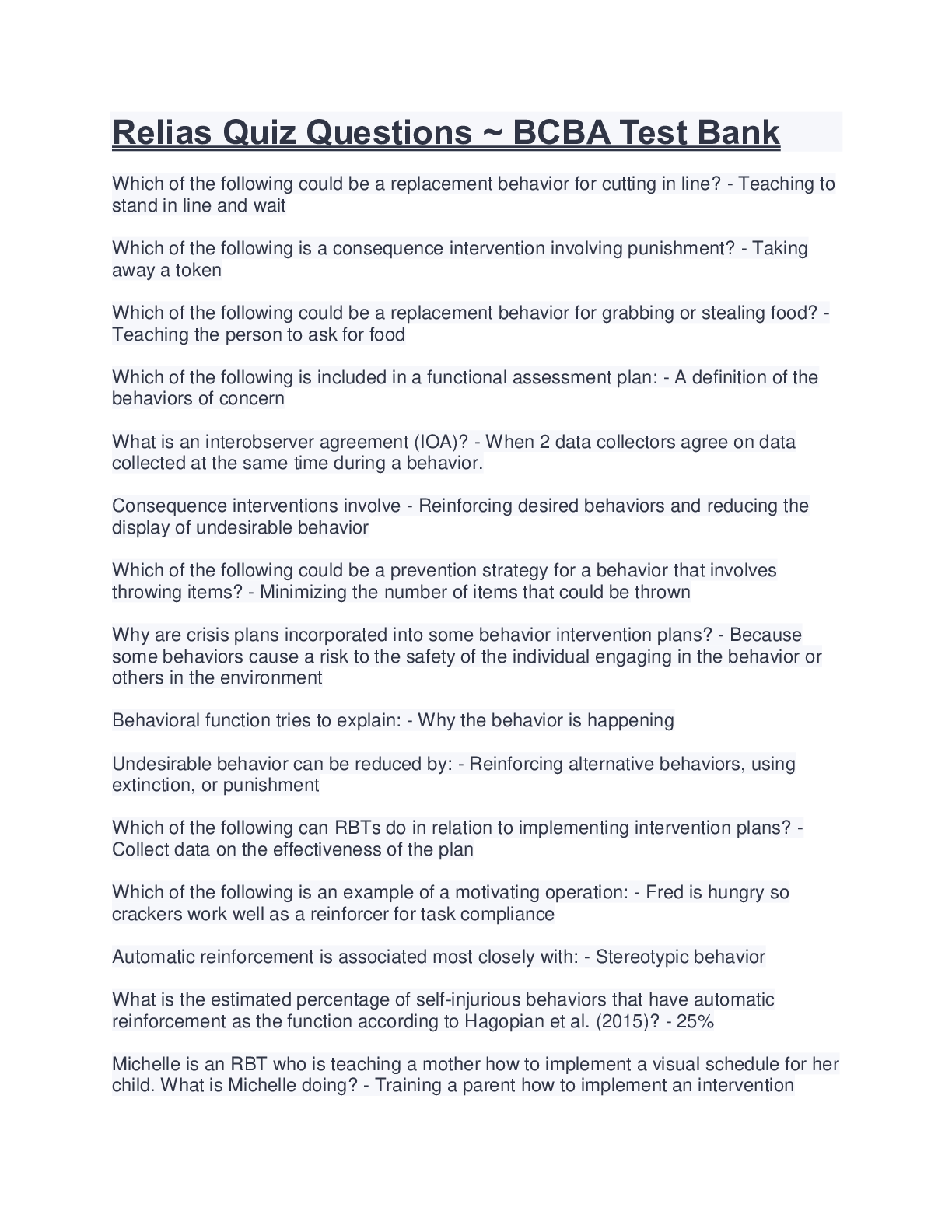
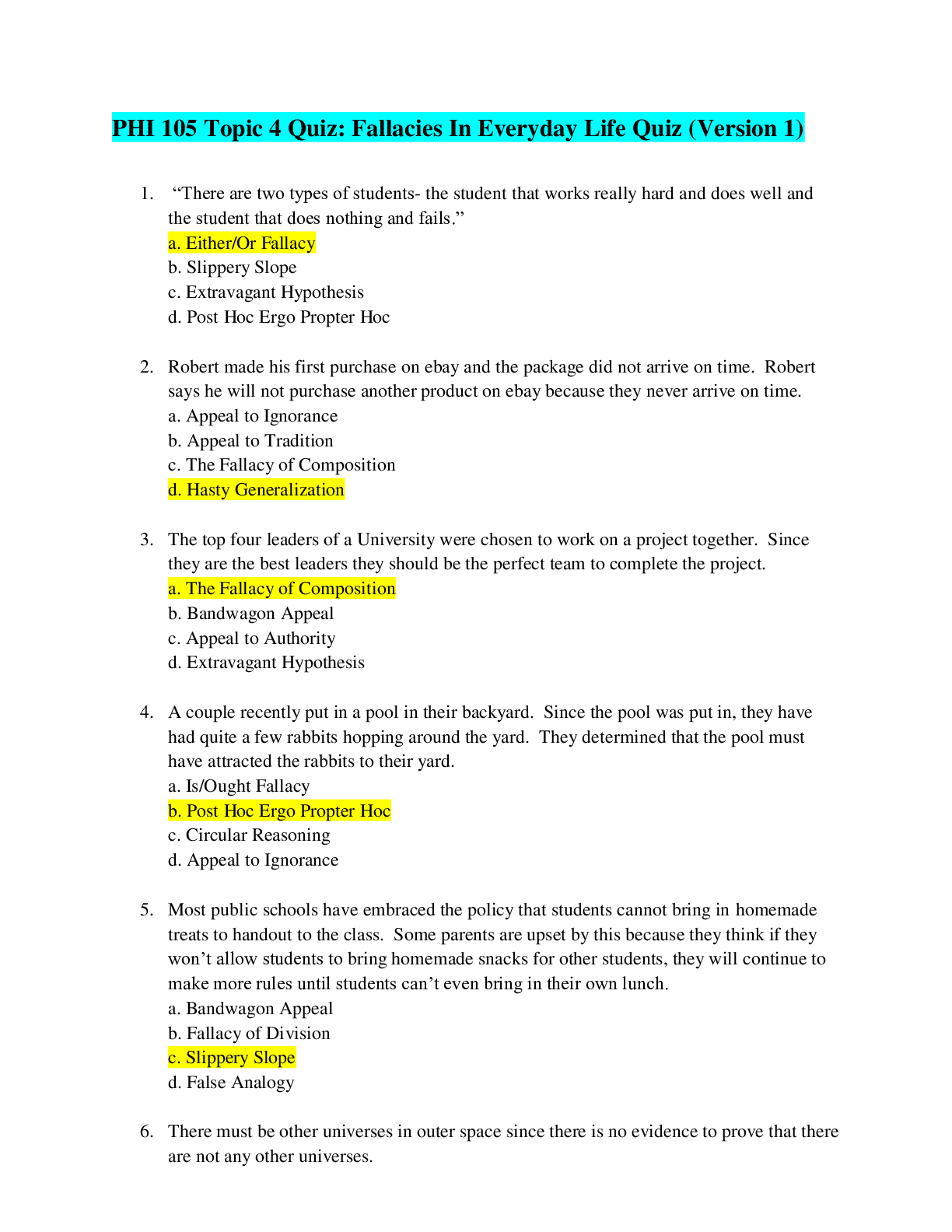


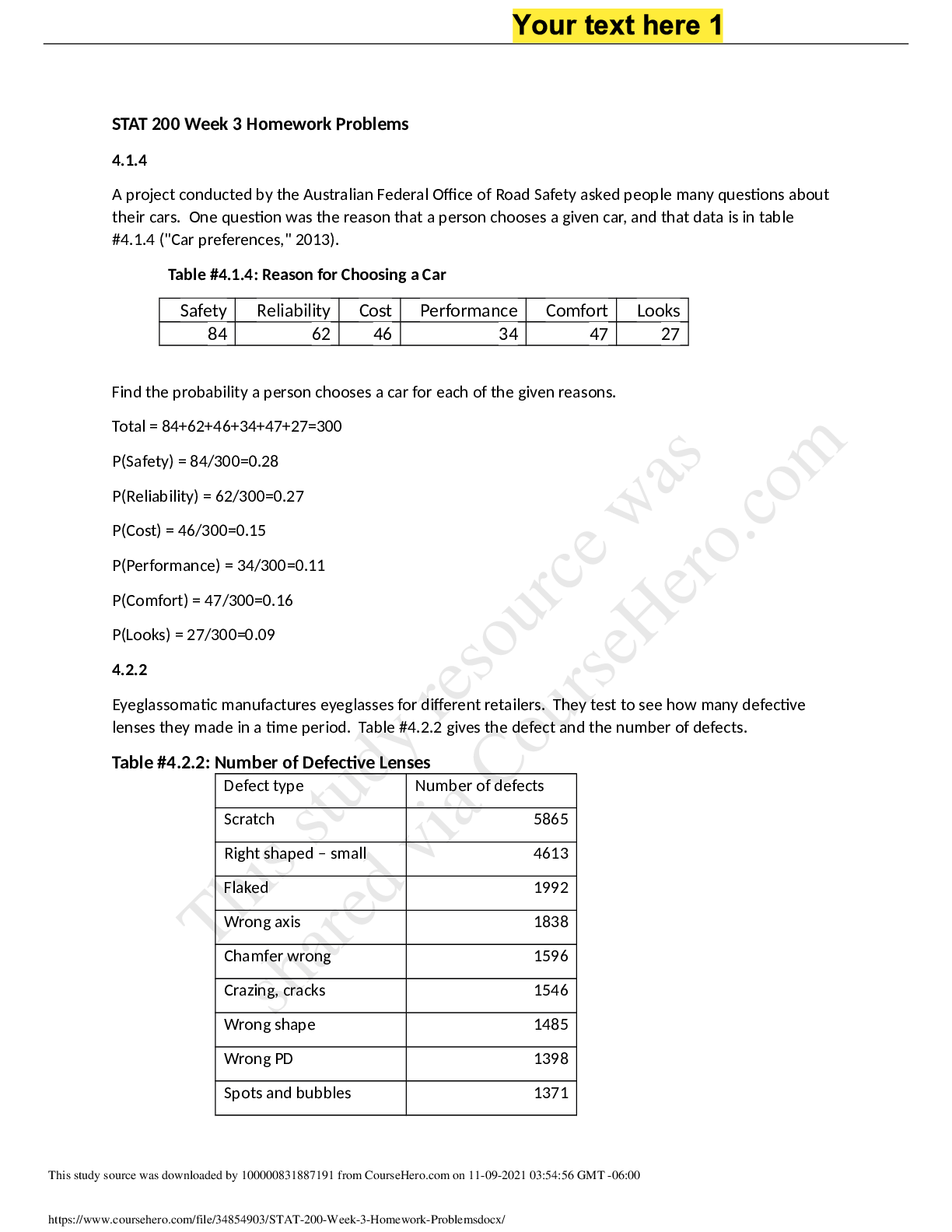

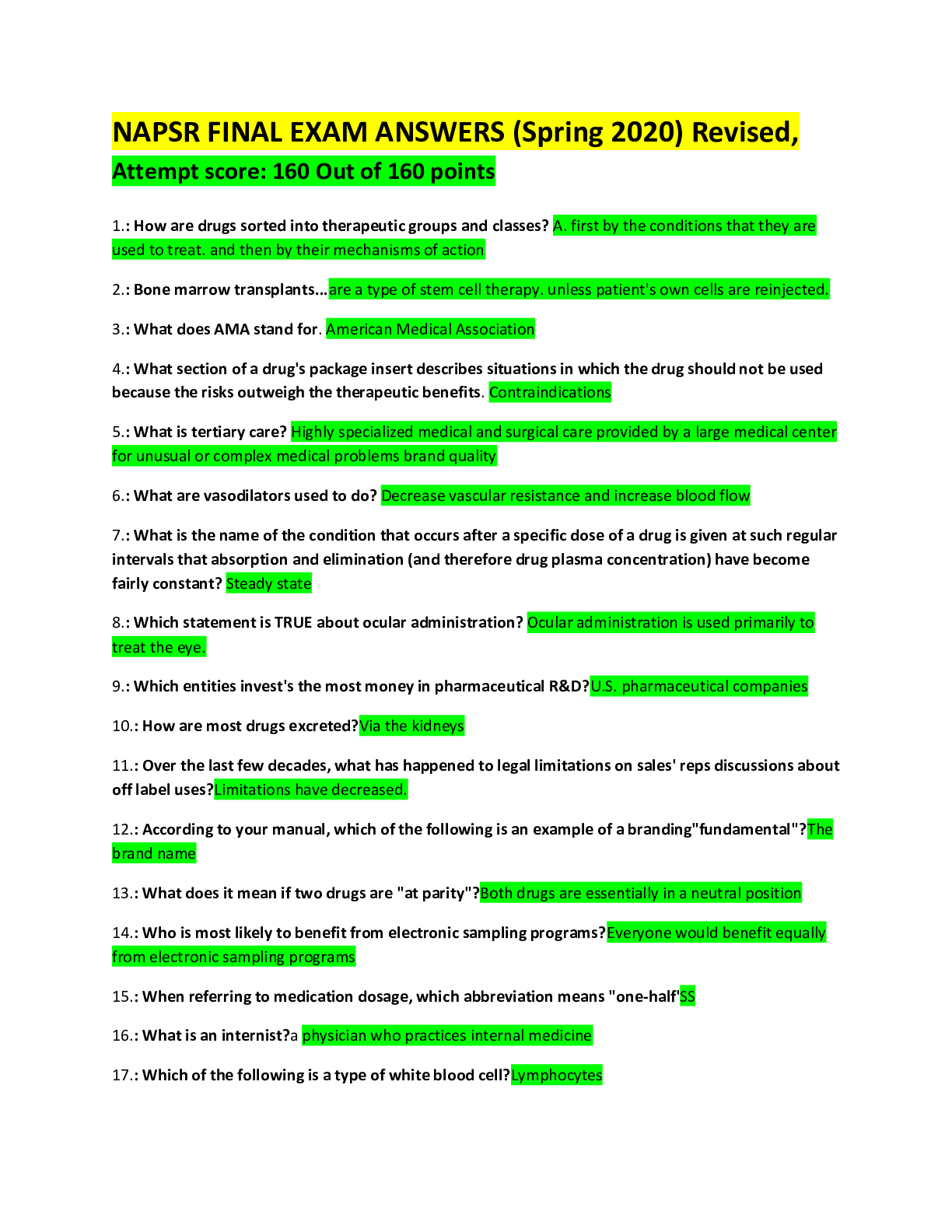

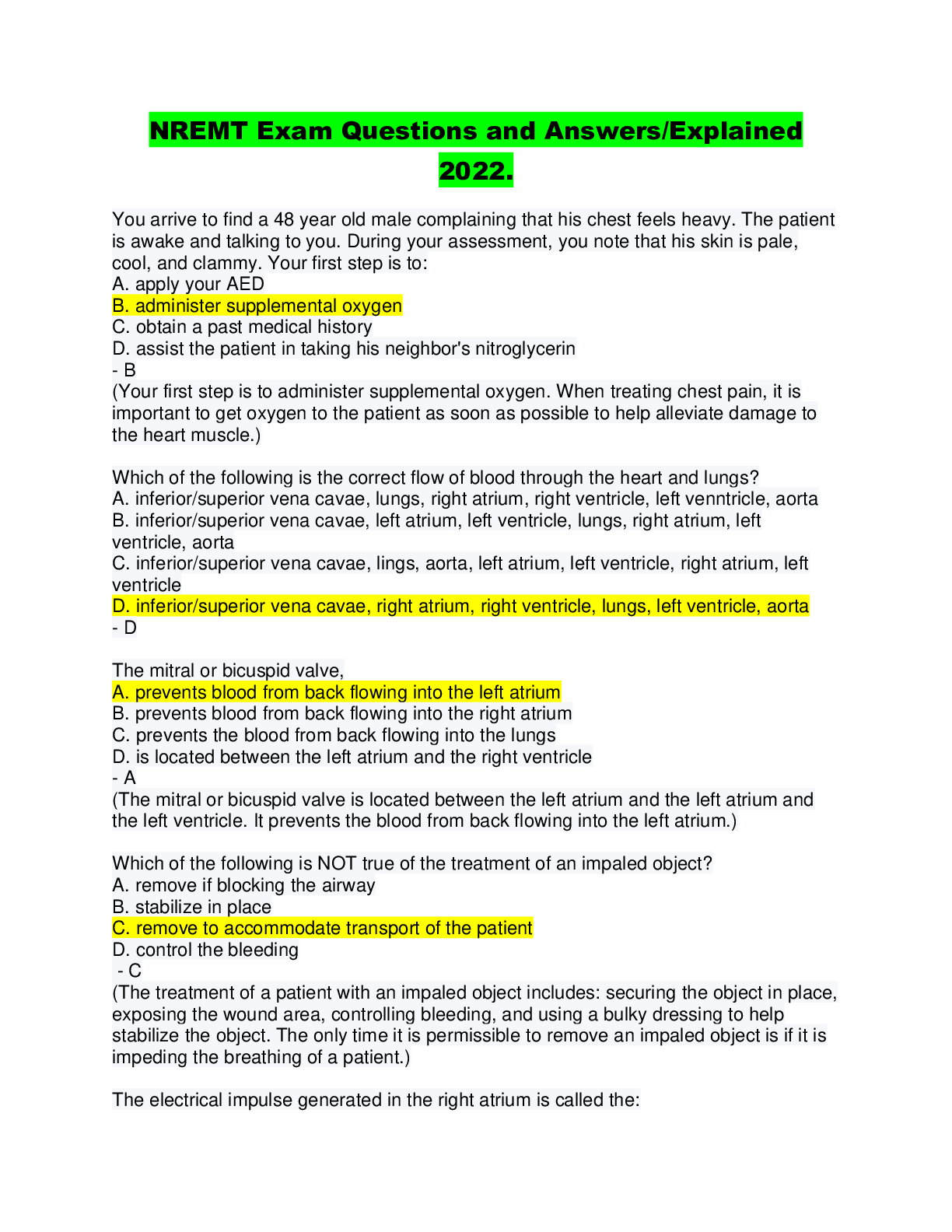
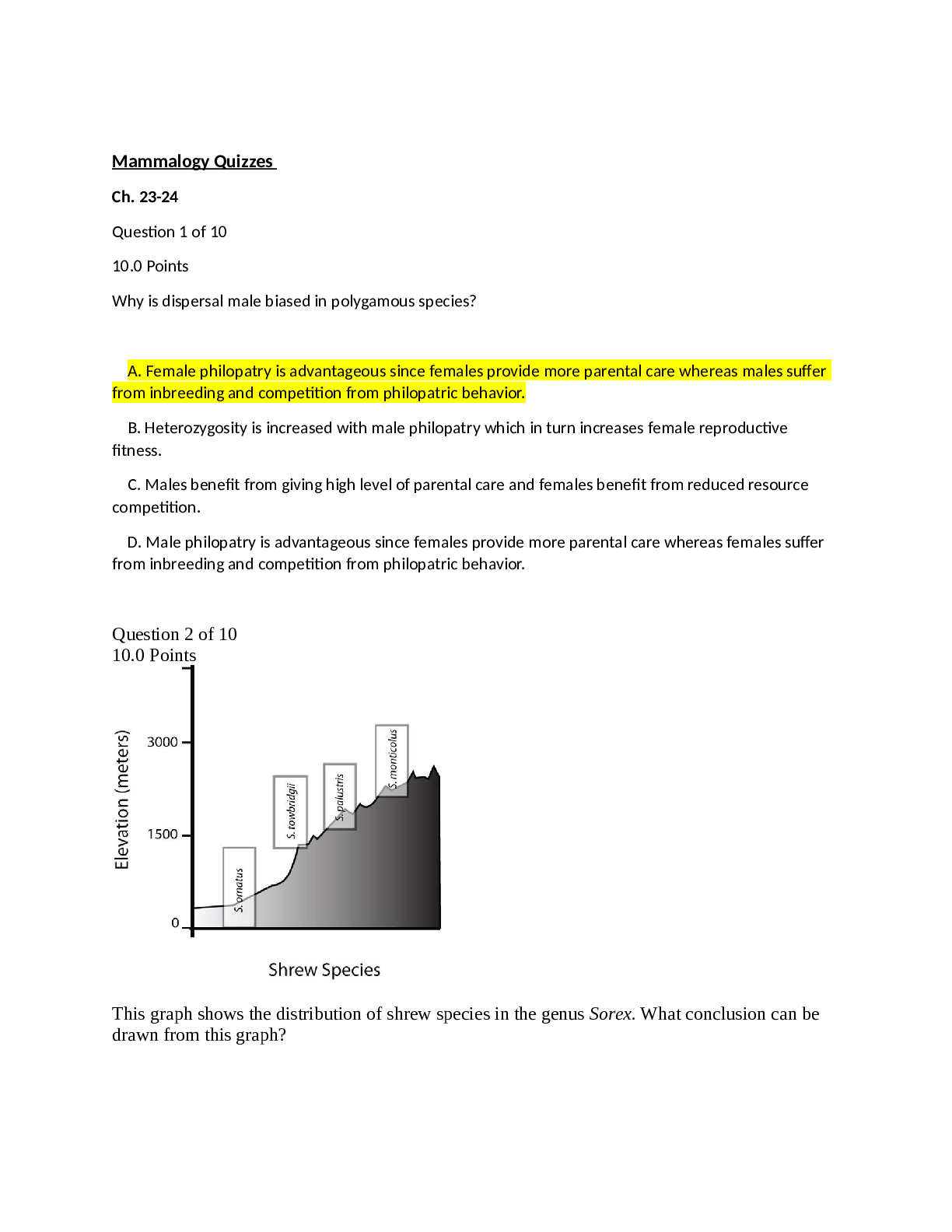
.png)

